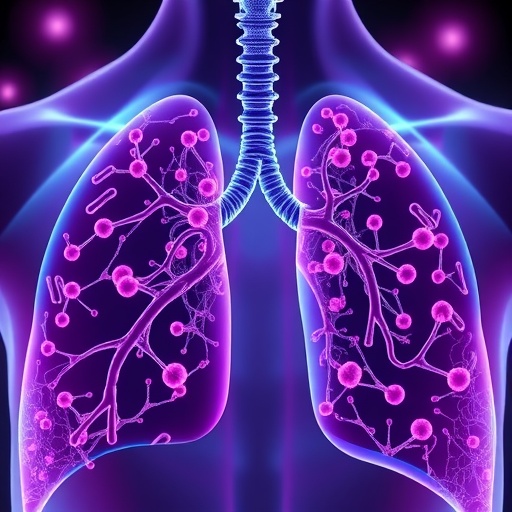In a groundbreaking advancement that could significantly shift the landscape of lung cancer treatment, researchers have developed an innovative dry powder inhalation formulation containing Crizotinib-loaded nanoparticles. This cutting-edge technology aims to tackle the widespread challenge of treating metastatic non-small cell lung cancer (NSCLC) with precision, while simultaneously minimizing the harsh systemic toxicity associated with traditional methods.
Crizotinib, a tyrosine kinase inhibitor, has had substantial success in targeting specific genetic mutations such as ALK and ROS1 in lung cancer patients, and it also shows promise against ALK-positive anaplastic large cell lymphoma and inflammatory myofibroblastic tumors. However, the clinical use of Crizotinib has been historically hampered by significant off-target toxicities which reduce patient quality of life and limit dosing options. Addressing these toxicities required an innovative drug delivery system that could localize Crizotinib specifically within the lungs, thereby reducing systemic exposure.
The team embarked on designing a dry powder formulation composed of polyethylene glycol-based polymeric nanoparticles (NPs) loaded with Crizotinib. Employing a method known as nanoprecipitation, these nanoparticles were engineered to encapsulate the drug efficiently, enhancing its stability and targeting ability. Optimization of the formulation was carried out using central composite design, a statistical modeling technique that allows for precise tuning of multiple parameters to achieve maximal performance.
A critical component of this research involved characterizing the aerodynamic properties of the dry powder formulation. Utilizing the Anderson Cascade Impactor, a device that simulates the deposition behavior of inhaled particles within the respiratory tract, the researchers observed a fine particle fraction of 56.2%, an indicator of particles small enough to reach the deep lung. Additionally, the particles exhibited a mass median aerodynamic diameter (MMAD) of approximately 1.5 µm, which falls within the optimal size range for efficient pulmonary delivery and deposition.
The physical and chemical properties of the nanoparticles were equally impressive. The particles averaged 167 nanometers in size, with a polydispersity index (PDI) of 0.462, revealing a relatively narrow distribution and uniformity favorable for consistent lung delivery. The zeta potential measured at -31.9 mV suggested good colloidal stability, an essential feature to prevent aggregation and ensure even dispersion upon inhalation. Most importantly, the encapsulation efficiency reached an impressive 82.3%, meaning a large proportion of Crizotinib was successfully incorporated within the nanoparticle matrix.
Further in vitro analyses showed that the polymeric nanoparticles not only preserved the pharmacological potency of Crizotinib but actually enhanced its anticancer activity compared to the free drug. These nanoparticles released the drug with 60.6% efficiency under laboratory conditions, indicating a sustained and controlled release profile conducive to prolonged therapeutic action at the site of disease.
To confirm the physicochemical integrity and composition of the nanoparticles, comprehensive characterization techniques were employed. X-ray diffraction (XRD) illustrated the crystalline or amorphous nature of the formulation, while differential scanning calorimetry (DSC) provided thermal profiles that reflect stability and potential interactions between Crizotinib and the polymer carrier. Fourier-transform infrared spectroscopy (FTIR) revealed key molecular bonding information, affirming the chemical compatibility between the drug and polymer. Scanning electron microscopy (SEM) visualized the morphological consistency and surface characteristics, which directly impact how these particles interact with lung tissues.
The significance of this technological breakthrough lies not only in the enhanced targeting of lung cancer cells but also in the potential to drastically reduce systemic adverse effects commonly encountered with oral or intravenous administration of Crizotinib. By delivering the drug directly to the lungs in the form of inhalable nanoparticles, drug concentrations can be localized exactly where needed, reducing off-target exposure and improving patient compliance.
This approach represents a crucial step forward in personalized oncological therapies, embracing the promise of nanomedicine and advanced drug delivery systems to tackle challenging malignancies. Besides lung cancer, such formulations could potentially be adapted for other diseases requiring localized pulmonary treatment, setting the stage for a new era in inhalation pharmacotherapy.
The researchers also anticipate that the dry powder formulation will enhance treatment adherence due to the non-invasive nature of inhalation therapy compared to current systemic treatments. It opens new horizons in managing lung cancer through minimally invasive methods that empower patients and clinicians with more effective options.
Moving forward, this research underscores the importance of interdisciplinary collaboration, encompassing pharmaceutical science, nanotechnology, and clinical oncology, to translate laboratory breakthroughs into tangible clinical benefits. The challenge now lies in navigating regulatory pathways and conducting comprehensive clinical trials to validate safety and efficacy in human patients.
Ultimately, this pioneering work paves the way for enhanced precision medicine in lung cancer, exemplifying how innovative formulations can redefine therapeutic strategies, optimize drug delivery, and improve patient outcomes. The exciting potential of Crizotinib-loaded inhalable nanoparticles represents a promising frontier where science meets real-world impact in cancer care.
Subject of Research: Advanced nanoparticle-based dry powder inhalation formulation for targeted delivery of Crizotinib in lung cancer therapy.
Article Title: Innovative inhalable dry powder: nanoparticles loaded with Crizotinib for targeted lung cancer therapy.
Article References:
Naureen, F., Shah, Y., Rehman, M.U. et al. Innovative inhalable dry powder: nanoparticles loaded with Crizotinib for targeted lung cancer therapy. BMC Cancer 25, 1526 (2025). https://doi.org/10.1186/s12885-025-15015-w
Image Credits: Scienmag.com




